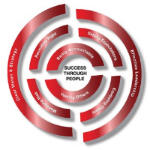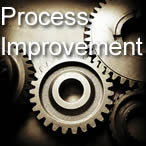It Will Improve your bottom line!!
Inventory management means keeping track of the goods you buy, process, or store as part of your business. The cost of buying and holding inventory can be very high. It can account for up to 80 percent of the final price of goods or services in some industries. Good inventory management involves minimising inventory costs.
It will also help you determine where you are working profitably and where you are making a loss. Keep a poor track of inventory and you may be making a loss in some areas of operation without even knowing it.
Inventory management involves more than just record keeping. It affects
the operational structure of your business.
What Is Inventory?
All the resources that you hold for future use or sale are classed as
inventory. This includes:
- Raw materials – anything that you will convert into a product or a tangible part of a service.
- Supplies – goods that support the production process such as office stationery or fuel to power machines.
- Partially transformed goods – your work-in-progress inventory.
- Work-in-progress inventory that you set aside as a buffer to work on in case of delays in production or supply.
- Finished goods, ready to be delivered or sold.
How Much Inventory Do You Need To Hold?
Your costs increase when you hold too much or too little inventory. If you have too much inventory you are paying money to store it for no good reason. If you have too little you risk delays in production or service delivery. Good inventory management means having the right amount of inventory, in the right place, at the right time.
Many businesses like to hold more inventory than they need for immediate use or sale. This is because reserve inventory can:
- Cover for unexpected quality problems in the production process.
- Smooth over unexpected production delays (such as supply problems caused by transport strikes, supplier bankruptcy, general supply scarcity or plant breakdown).
- Minimise downtime caused by such disruptions.
- Provide the capacity to respond quickly to unexpected demand increases.
- Generally improve the reliability of the production process.
- Take advantage of bulk purchase discounts.
But there is a downside to holding inventory:
- The cost of storage.
- The risk of inventory theft or decay.
- The loss of value of inventory items (through obsolescence, for example).
- The administrative costs of ordering, transporting, handling and keeping track of inventory.
Deciding how much inventory to hold is partly a matter of weighing up costs and benefits. It means analysing when and where you will have a crucial need for inventory. To carry out this analysis you need to take a close look at your business processes and identify internal and external demands for inventory. You could do this yourself, but it is advisable you run your conclusions by your business advisor or accountant for feedback.
Consider Internal And External Demands
Mapping out your business processes will help you understand your internal demands. If you are a manufacturer, your process map will show you when and where you need materials.
Internal demands can be quite complex, even for a small operation, as you may need to keep track of a large number of supplies and components. Mistakes can be costly. Say production is higher than usual for the month – production may be held up if someone has forgotten to cover for higher production by ordering more of one critical component (paint, for example). Your inventory management systems should
prevent such mistakes from occurring.
Inventory management also requires you to keep in touch with market demand. You need to stay in touch with larger economic or market trends. But you also need to keep a close eye on how products are being sold. If you are a retailer with several outlets, for example, you might find certain products sell better in certain areas.
Keeping a close eye on sales will help you decide how much to ship, so that shelves are neither overstocked nor empty. This can be particularly important if you are selling perishable goods or goods that follow seasonal demand (such as fashion).
Consider Your Operational Structure
Your inventory management systems need to fit in with the kind of operation you run and the way you respond to customer demand.
Resource to order
If you are running a ‘resource to order’ operation, it means that you stock resources in response to individual customer orders. If you are a caterer, for example, you will buy stock for particular events. Or if you run an engineering company, you may stock up for particular construction projects.
You deliver a highly customised product to your clients and this flexibility is likely to be seen in all parts of your operation. You are likely to have a multi-skilled workforce that is highly sensitive to customer demands. Your inventory needs will vary according to the job or project you are working on.
Make to order
If you are running a ‘make to order’ operation, you keep a standard inventory but produce a customised product. For example, you might run a small sandwich shop. You keep a range of ingredients and make the sandwiches according to individual customer orders.
Or you might run a small computer retail operation and use standard components to build a computer to customer requirements. One customer might require a large monitor, for example, or a particularly fast processor. Though your inventory is standard, you are still running a flexible operation and you will expect your team members to take initiative, show a range of skills, and fill in for each other on occasion.
You will not produce goods in any predetermined sequence and your component needs will vary according to each customer’s wishes. You will need to stock inventory to meet a range of possible needs.
Make to stock
‘Make to stock’ operations tend to produce a high volume of standardised products. For example, if you run a sandwich shop that makes and sells pre-packaged sandwiches, you are making to stock. Or if you are
a manufacturer who produces a line of standard alarm clocks, you are making to stock.
Your inventory needs will be simpler, in one respect, as you will need components and supplies in standard and predictable proportions. You will not be able to customise to attract individual consumers. But you
will produce high volumes of a standard product, giving you access to economies of scale.
This type of operation traditionally requires a less skilled workforce, though modern approaches such as lean manufacturing are changing this.
When you consider your inventory management, think about the sort of operation you run. It will affect how closely you need to monitor your inventory, how often you need to monitor stock levels, and how predictable your inventory demands are likely to be.
Focus on Inventory
There are many other aspects to inventory management such as monitoring inventory; inventory management software for manufacturers; Just-In-Time goods delivery techniques; retail trade inventory; addressing excess inventory problems; tagging methods. InForm Consulting Group can give you more detailed information and guidance about these important considerations. Inventory management is a key part of your business. It does not matter whether you are running a small or medium-sized company or whether you are delivering goods or services. Inventory management can make the difference between
running in the red, or in the black.






